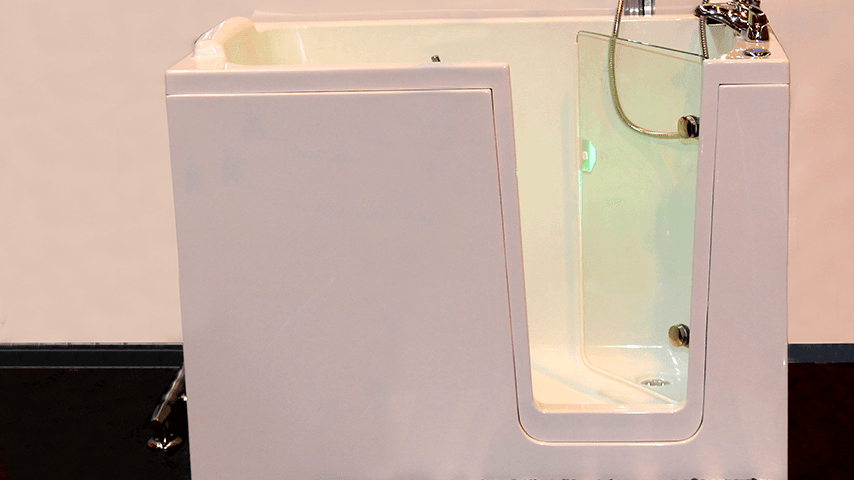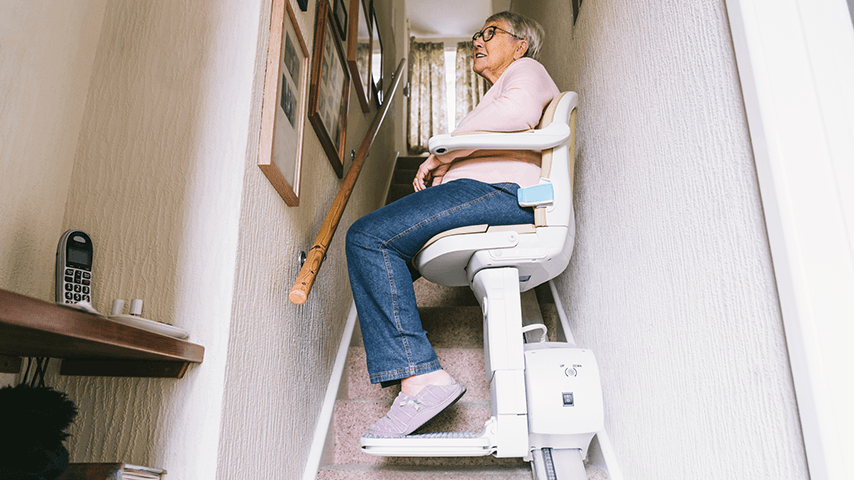How Much Do Walk-In Tubs Cost?
15 min read

A bathroom is an essential room in any home.
It’s also a hazardous one. Tight spaces, wet surfaces, and loose floor mats increase our chances of slipping, tripping, and falling. And then there’s the shower, which can be particularly tricky to get into and out of as we age.
“As we age, it becomes more common to experience age-related changes to our mobility, strength, or balance,” said Dorothea Vafiadis, Senior Director of NCOA’s Center for Healthy Aging. “ Conditions like arthritis, side effects from medications such as dizziness or diabetic neuropathy that reduces sensation in our feet can increase our risk for falls especially in places like the bathroom, where stepping over the edge of the tub or shower can be hazardous.”
But many falls and their related injuries can be prevented. You can find ways to live injury-free from falls by planning ahead and creating a plan that might include installing a walk-in tub or a stair lift. At the same time, Vafiadis explained, bathing is a key activity of daily living (ADL)—one of several basic tasks that indicate our ability to maintain independence and quality of life.
“If you’re afraid of falling in the shower, avoiding it may seem like the safest option, ” she said. “But regular bathing is essential for maintaining health and independence, especially if you want to continue living at home. Simple changes to your bathroom, such as improved lighting and installing grab bars can help address the problem.”
Depending on individual needs and preferences, a walk-in tub can be an important home modification.
By removing the literal barriers to entry, these tubs may make it safer and easier to age in place and live independently for longer. And many offer additional perks as well, like therapeutic jacuzzi jets that can ease joint and muscle pain.
Should you (or someone you help care for) get a walk-in tub? Is the cost affordable?
There are many factors to consider, including purchase price, features, and installation costs.
How much do walk-in tubs cost?
What you will pay for a walk-in tub depends on the brand, features, and whether you need to change anything in your bathroom to accommodate it, among other things. Generally speaking, costs will range between $2,500–$17,000 or more. This at-a-glance chart shows the major breakdowns for you:
Cost comparison by walk-in tub type
|
|
BASIC (soaker) |
HYDROTHERAPY (jetted) |
LUXURY (multi-feature) |
|
EQUIPMENT COST |
$2,000–$5,000 |
$5,000–$8,000 |
$8,000–$12,000+ |
|
INSTALLATION COST* |
$1,000–$5,000 |
$1,000–$5,000 |
$1,000–$5,000 |
|
TOTAL ESTIMATE |
$3,000–$10,000 |
$6,000–$13,000 |
$9,000–$17,000+ |
*Installation fees depend on individual circumstances including any additions or modifications to electrical or plumbing; structural changes; and regional differences in the cost of goods and labor.
Now, let’s take a closer look.
Several variables influence the total price of a walk-in tub. These include:
Type of tub
$2,000–$12,000+
Choosing the tub type boils down to your individual preferences, your space, and—of course—your budget. Do you want a tub with a “spa” feel, or will a simpler, non-jetted option work for you? Will it fit the current footprint of your existing tub or will you need to modify or renovate your bathroom to accommodate it? Don’t forget to consider any specific needs, such as wheelchair accessibility or other mobility accommodations.
In general, walk-in tub models fall into the below categories:
|
Tub Type |
Cost |
Description |
| Soaker tub | $2,000–$5,000 | These non-jetted tubs offer the most affordable entry point. At the low end, soaker walk-in tubs offer a basic design and standard safety features including non-slip surfaces and low thresholds. Higher-end models may include extra safety features like grab-bars and upgraded comfort options like heated back rests. |
| Whirlpool tub | $5,000–$8,000 | Sometimes called “hydrotherapy” tubs, these jetted models offer therapeutic massage, much like an outdoor hot tub. At the low end, whirlpool walk-in tubs include a standard number of water jets without much ability to adjust their intensity. More expensive models offer more jets with higher intensity and customizable placement. |
| Wheelchair accessible tubs | Varies | These specialty walk-in tubs are designed for easily transferring from a wheelchair and into the tub. Basic models include wider doors, ADA-compliant seats, and handrails. Keep in mind: these either can be soaking tubs or whirlpool tubs, so costs will vary depending on type and additional features. Expect to add several hundred to several thousand dollars to the above prices for one of these tubs. |
| Bariatric tubs | Varies | These specialty walk-in tubs are designed to accommodate people who are heavier or have larger frames. Basic models include reinforced construction and a roomier seating area. As with wheelchair-accessible models, bariatric tubs also can be soaking tubs or whirlpool tubs; costs will rise depending on the type of tub and any upgrades you choose. You easily may pay several thousand dollars more. |
Material
$2,000–$12,000
Most walk-in tubs are made either of acrylic or coated fiberglass. Both have their pros and cons. When choosing your tub’s material, consider your tolerance for things like cosmetic wear and tear (will you mind scratches or fading, for example?); heft (will you need to reinforce your floor with a heavier tub?); and longevity (are you willing to take on the additional cost of repairs if the material cracks, warps, or fails?). Keep in mind that material costs will depend on the type of walk-in tub you choose—basic soaker, whirlpool, or specialty model—and the cost of the material is generally already factored into the price. It’s a good idea to ask about this, though; sometimes, acrylic models are offered as an upgrade.
|
Material Type |
Cost |
Description |
| Fiberglass | $2,000–$5,000 | Fiberglass tubs are the least expensive. They’re lightweight and usually easier to install; on the flip side, they can be less durable over time. |
| Acrylic | $5,000–$12,000 | Acrylic tubs cost more. They’re sturdier and resist visible wear and tear; on the flip side, they’re usually more labor-intensive to install. |
Special features
$100–$5,000+ each
Once you’ve decided to purchase a walk-in tub, you’ll have the option to upgrade its features: add-ons to enhance safety, comfort, and convenience. And the sky’s really the limit. Consider what you absolutely need to have in a walk-in tub, versus what might be nice to have if you have extra budget to work with. Often, your best cost-savings happens when you can be honest and selective about features and accessories. These include things like:
Safety upgrades
- Additional grab bars
- Anti-slip surfaces
- Anti-scald faucets
- Built-in seat(s)
- Lower step-in threshold
Convenience upgrades
- Hand-held shower attachment
- LED lighting (chromotherapy)
- Quick-fill faucets
- Rapid-release drains
- Self-cleaning technology
Comfort upgrades
- Aromatherapy
- Built-in water heater
- Massage jets
- Heated back rests
- Shower / tub combination
Ongoing upkeep
Cost varies
There are few ongoing costs to be aware of when it comes to walk-in tubs. First, your water and energy usage. Some walk-in tubs can hold between 80–120 gallons of water; depending on how often you fill yours, you may notice higher utility bills. Second, you may need to factor in minor maintenance costs for things like replacing LED bulbs and refilling aromatherapy canisters. Beyond that, regularly cleaning your tub and jets will go a long way toward keeping your maintenance costs low.
You also will want to look into:
- Basic warranty: Most reputable walk-in tub brands offer a limited lifetime warranty that covers any material or manufacturing defects for as long as you own your home. Normally, this warranty is included with your purchase. Buyer beware, however: it may depend on whether you purchase directly from an authorized dealer and require professional installation. Be sure to read the fine print and compare different brands to find the coverage that works best for you.
- Extended warranty: Some brands offer additional warranty coverage for extra cost. You might be able to extend the terms of your basic warranty, for example; you may also be able to add coverage for specific components, like the electrical panel, hydrotherapy jets, or heating element. Whether this coverage makes sense depends on your budget and tolerance for the unknown. Does it make sense to pay a lump sum up front for hypothetical repairs; or take a gamble and potentially need to pay to fix something later?
Finally: Keep in mind that—no matter the tub type, materials, or features you choose—certain brand names will always command a higher price. It’s worth taking the time to research brand reputation to help determine whether the additional cost is worth it for you. Check online product and user reviews and ask people you know about their experiences.
Walk-in tub installation costs
Depending on your space, adding a walk-in tub can be straightforward or remarkably complex. The below information serves as a general guideline; but it always makes sense to contact local retailers to set up a free, no-obligation in-home consultation (all reputable walk-in tub dealers will offer this service). This is the best way to get the most accurate pricing for your particular situation and area where you live.
|
Installation Type |
Cost |
Description |
| Basic installation (retrofit) | $1,000–$2,500 | The most economical installation involves a simple swap-out: replacing your existing tub with the new walk-in tub without having to change the footprint, floor joists, or utilities. |
| Advanced installation (remodel) | $3,000–$5,000+ | The more complex the work involved, the more it will cost to have your walk-in tub installed. We cover some of these scenarios below. |
Additional considerations
Cost varies
When estimating the work, contractors will need to factor the following into their price. Costs to have your walk-in tub installed may increase depending on your individual situation, including:
- Plumbing:
- Do you need to relocate your pipes or add new ones?
- Where will they go, how long will they be, and how many joints will they require?
- Electrical:
- Are there sufficient outlets nearby?
- Are they the appropriate voltage for the tub and are they GFCI rated?
- Will your panel need to be upgraded?
- Physical build
- Will the tub fit through the existing bathroom doorway?
- Do you need to alter the footprint of the room, move existing fixtures, or reinforce the flooring?
Keep in mind: How much you will pay in additional parts and labor depends on where you live. According to the U.S. Bureau of Labor Statistics, the mean hourly wage for a plumber is $32.70; for an electrician is $32.60; and for a carpenter is $29.31.
Ways to save on walk-in tub costs
It’s easy to see how the costs of a walk-in tub can add up quickly. But there are ways to lower the price tag, NCOA’s Vafiadis pointed out.
Here are a few ideas:
Health and long-term care policies
Original Medicare (Medicare Part A and Medicare Part B) will not cover walk-in tubs because they are not considered “durable medical equipment.” But some other insurance plans might, including:
- Medicare Advantage: Many Medicare Advantage (Part C) plans offer additional benefits that may help pay the cost of a walk-in tub. It depends on the insurance provider and plan, however, and restrictions often apply. Check your policy documents for specific eligibility guidelines; and if you’re still not sure, call your insurance provider directly to ask.
- Medicaid: Some states offer home and community-based services waivers (HCBS Waivers), which help eligible Medicaid enrollees age in place rather than enter a skilled nursing facility. HCBS Waiver programs may provide grants to pay for home modifications, including accessibility upgrades like walk-in tubs—but it depends on where you live. Reach out to your state’s Medicaid office to learn more.
- Long-term care policies: Long-term care insurance might cover all or part of the However, this tends to be rare and often requires proof of medical necessity. Reach out to your insurance broker or plan administrator. Ask whether and how much coverage you might have for a walk-in tub and if you need to provide a doctor’s certification for why you need one.
Special promotions
Many walk-in tub dealers offer special price incentives. Ask about rebates, discounts, and seasonal sales; for instance, around Safe at Home Week in August or Falls Prevention Week in September. It’s worthwhile to do some research, advised Vafiadis, because these incentives can differ significantly. And don’t hesitate to ask whether you qualify for non-advertised discounts, too. Some brands and vendors will apply special reductions for military veterans or people with low incomes.
Grants and other financial assistance programs
In addition to checking your insurance policies, there are a few other options to investigate that may help pay the cost of a walk-in tub. These include:
- Manufacturer’s financing plans: Many companies and dealers are willing to work with you: offering low- or no-interest monthly payments for the walk-in tub, installation, or both. Check websites or ask a sales representative about financing options. Sometimes companies partner with third-party lenders, which is important to know about up front.
- VA benefits: If you’re eligible for military veterans benefits, the U.S. Department of Veterans Affairs offers several programs that can help pay all or part of the cost of a walk-in tub. These include:
Specially Adapted Housing Grant (SAH)
If you have a qualifying service-connected disability and own or plan to own your home, the SAH grant program provides a maximum of $121,812 to buy, build, or modify it to accommodate your accessibility needs.
Special Home Adaptation Grant (SHA)
Similar to the SAH, the SHA grant helps you—or a family member you live with—buy, build, or change your permanent home. An SHA grant covers a narrower set of qualifying service-connected disabilities and offers up to $24,405.
Home Improvement and Structural Alterations Grant (HISA)
If you have a qualifying service-connected disability, a HISA grant might help you pay for a walk-in tub. However, the rules are strict and do not cover spa-like models. You also must provide a letter of medical justification from a VA-approved physician.
Your state Veterans Service Officer can help you understand and apply for one or more of these disability housing programs if you qualify. Find yours here.
- Federal loans and grants: The U.S. Department of Agriculture’s Section 504 Home Repair Program helps low-income homeowners repair, improve, or modify their houses to make them more accessible. This can include adding a walk-in tub. In order to qualify, you must be age 62 or over, live in an eligible rural area, and meet your county’s definition of “very low income,” among other rules. Contact your state USDA loan specialist to learn more.
- State loans and grants: The U.S. Department of Housing and Urban Development awards millions of dollars in grant funding to states and nonprofit organizations through its Older Adults Home Modification Program (OAHMP). These funds are intended to help residents remain safely in their homes as they age. Programs and eligibility rules depend on where you live. Visit HUD’s state directory to learn about options in your area.
- Nonprofit grant programs: Several national organizations offer financial and technical assistance to help people with low incomes safely age in place and continue to live independently in their homes. Learn more about opportunities through Rebuilding Together’s Safe at Home initiative, and Habitat for Humanity’s Aging in Place program. Your local area agency on aging can direct you to additional resources as well.
- Federal and state tax deductions: Can you get a tax break for making accessibility upgrades to your home? Maybe. But there are several important caveats, including whether these upgrades are considered “medically necessary” under the IRS code. Further, these deductions may only make sense if you itemize your returns. A certified tax accountant or other financial professional can help you navigate these laws, which change often.
Are walk-in tubs worth the cost?
“That’s a tough question to answer universally,” said NCOA’s Vafiadis. “It’s a highly personal decision and depends on so many things beyond budget.” Still, she said, there are clear benefits to consider that can help you determine whether or not the investment makes sense for you or someone you care for. These include:
Health and quality of life
Most of us would like to stay in our own homes as we grow older. A walk-in tub can help both maintain independence and support the ability to more safely age in place by:
- Reducing the risk for falls
- Maintaining the ability to perform a basic activity of daily living
- Providing therapeutic relief for joint and muscle pain
Professional services
Compared to the costs of in- or outpatient rehabilitation or moving into a care community, a walk-in tub can provide an economical alternative. Tubs with therapeutic features may help patients recover from certain injuries, surgeries, and health conditions (always consult your health care provider). And tubs with additional accessibility features may delay or reduce the need to move into assisted living or to hire personal care assistants for bathing tasks. Consider these median costs for 2024, found using Genworth’s Care Scout tool:
- Home health aide: $6,483 per month / $77,796 per year
- Assisted living community: $5,900 per month / $70,800 per year
- Skilled nursing facility: $10,646 per month / $127,752 per year
“Of course, the decision to hire a home health aide or move into a care community involves factors beyond just your ability to get into and out of the tub,” Vafiadis said. “But if safety and accessibility are your primary concerns, it absolutely makes sense to consider home modifications as part of the overall decision-making process. After all, most falls happen at home.”
The bottom line
Traditional tubs are a significant hazard, especially as we age. Changes to our mobility, strength, and balance raise the risk for tripping, slipping, and falling—which can be devastating to our independence and ability to live at home.
Walk-in tubs offer a practical solution. The cost can be significant—ranging between $3,000–$17,000+ installed—but there are many options to help pay for one.
These include no- or low-interest dealer financing as well as federal and state home modification loans and grants. These programs specifically intend to help people with mobility challenges improve the accessibility and safety of their living space. The U.S. Department of Veterans Affairs, U.S. Department of Agriculture, and the U.S. Department of Housing and Urban Development offer such programs. So do several national nonprofits serving older adults and those with disabilities, including Rebuilding Together and Habitat for Humanity.
Frequently asked questions
What is the average cost of a walk-in tub with installation?
It depends on three things: whether you choose a non-jetted or jetted model; what upgrades you elect, if any; and how simple or complex the installation will be. Based on the figures in Table 1, you can expect to pay an average of $6,000 on the low end and $13,000 on the high end.
Can seniors get financial assistance for a walk-in tub?
Yes. In addition to low- or no-interest manufacturer’s loans, there are several home modification grants available through federal, state, and nonprofit organizations. These grants may cover some or all of the cost of a walk-in tub. Scroll up for more detail in the article above.
What’s the cheapest walk-in tub option?
You will pay less for a soaking (non-jetted) model made of fiberglass. As with all consumer products, however “cheap” doesn’t always equate to “inexpensive.” Some brands may be poorly constructed regardless of price. It’s important to read product reviews and consult the Better Business Bureau rating before you buy.
How long does it take to install a walk-in tub?
Only your contractor will know for sure. Many reputable dealers will send an estimator to your home for a free, no-obligation consultation. This is the best way to understand all the factors that impact price and timing.
Questions? Email us at reviewsteam@ncoa.org.



